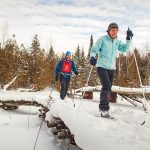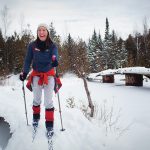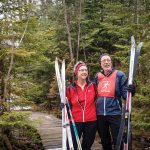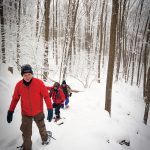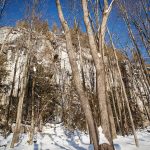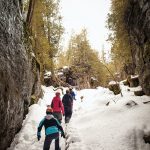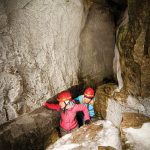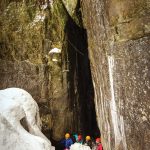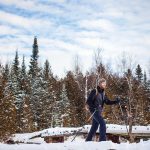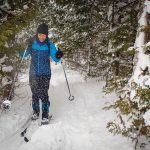Explore the magic of winter in the Kolapore Uplands
by Laurie Stephens
by photography by Kristie & Brenden Woods
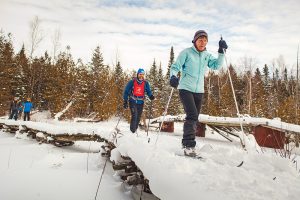
Catherine Smart’s first experience cross-country skiing in Kolapore Uplands many years ago was memorable, to say the least.
Introduced to the rugged wilderness area by friends, a pregnant Smart and her partner, Stephen Couchman, went for a ski with them and promptly got lost, despite the fact that they were both skilled outdoor enthusiasts who were former Outward Bound instructors.
The experience had two consequences. For one, they fell in love with Kolapore and shortly thereafter decided to leave Toronto for Clarksburg in order to be closer to their winter paradise. And second, from that point onward, they made sure they carried maps whenever they skied the Uplands.
“I have to say, it’s one of the gems on this planet,” says Smart. “It’s a really beautiful forest. It’s diverse, it’s got this wonderful feel to it, and depending on how you’re feeling that day, you can do a very good push ski or a little gentle ski. It’s just super-duper beautiful.”
She and Couchman particularly like to ski the Kolapore Uplands in intense weather, and she recalls one outing at the end of a really cold day – about minus 30 – when they did a loop before the sun went down. By the end of the ski, she was covered in icicles – a fact documented by pictures she posted to Facebook.
“It was like Narnia in there!” she marvels. “People were blown away that we were out there in that weather and they thought that we were beyond insane.
“You didn’t stop for very long, because you didn’t want to get cold, but it was a really fantastic experience. It was so beautiful; the trees were laden with snow, and it was so unbelievably magical.”
A popular destination for mountain bikers and hikers in the summer, Kolapore takes on a whole new personality in winter, transforming into a wonderland of snow and ice that blankets the harsh terrain. Bikes and hiking boots make way for cross-country skis and snowshoes, although never the twain shall meet, at least in certain parts of the wilderness area.
Primarily Crown land, Kolapore Uplands is located along the Niagara Escarpment, just south of Thornbury and northeast of Flesherton. The Bruce Trail runs across the northern edge of the area and features a number of breathtaking lookouts – including the stunning Metcalfe Rock – from vantage points as high as 300 metres above Georgian Bay.
The trails in the Uplands are managed by the Kolapore Wilderness Trails Association (KWTA), a non-profit organization of more than 140 volunteers dedicated to maintaining a 50-kilometre web of routes that, in winter, are for cross-country skiers only.
Ungroomed trails over rocky topography make most of the area a very technical and challenging outing. Moreover, the network is not a set of easy-to-follow loops; rather, it is a series of inter-connected trails that give skiers all kinds of options to traverse on any given day. The longest trail around the perimeter is about 25 kilometres.
It is an experience recommended primarily for intermediate or experienced back-country skiers. “It’s certainly not for the faint of heart,” says Couchman, 49, a self-described cross-country ski junkie who joined the association more than five years ago. “I’m in there probably five days a week in ski season, and part of what I do there is rescue people who have gotten themselves completely lost.”
His best advice: “Take a map! You can get yourself into some fairly serious trouble if you don’t know where you are or what you’re doing.”
Couchman uses Kolapore as a training ground for a two-day, 160-kilometre Nordic ski tour called the Canadian Ski Marathon that he enters each year. The technical, demanding parts of the Kolapore trail network prepare him well for the grueling event that runs from LaChute to Buckingham, Quebec.
For less experienced skiers, Couchman recommends the many shorter, easier loops in the south end of the network, as they are more gentle while still “stunningly beautiful.” This area is also scheduled for some trail improvement work by Grey County that will expand the amount of terrain suitable for beginner skiers.
While Kolapore Uplands is now a popular site for warm weather activities like mountain biking and hiking, it wasn’t always so. The trails were originally built just for back-country skiing, says Bruce King, 66, president of the wilderness association and a founding builder of the trail network.
As a University of Toronto student in 1973, he and a few other members of the UofT Outing Club (UTOC) visited a series of trails in the Laurentian Mountains that were maintained by the McGill University Outing Club.
“We came back from that trip and one of our members went out and skied around the Metcalfe cabin (owned by UTOC) and came back and said, ‘Why don’t we do something like the trail network that the McGill outing club has in the Laurentians here?’”
The rest, as they say, is history. The group put together a grant application to the federal government to hire students to begin work on the trail network that summer, and the trails were in place within a few years after that. Most of the early work was done by UTOC members, but these days its involvement is minimal. For the last 15 years, the network has pretty much been a local effort, says King, with occasional help from current UTOC members.
“There are a couple of myths,” says King. “Some people think the government looks after the trails, and they don’t; the other is that they’re somehow university affiliated, and they aren’t. In both cases there’s a kernel of truth: the government provides the land on which we manage the trails, and the Outing Club provided the framework for getting the trails going.”
King himself has been skiing the trails for more than 40 years. Originally a “weekender” – he built a home near the southeast corner of the trail system in 1990 – he became a full-time resident six years ago. He has been president of the association since it was incorporated in 2011.
Kolapore Uplands is where he learned how to ski. When he went skiing in the Laurentians as a university student, he says he spent most of his time on his back. But when he began skiing at Kolapore, weekend after weekend, his technique improved and he had more fun. Now he is truly hooked.
“The trails, you never get tired of them,” he says. “They’re different every day, and that’s one of the things with non-machine-groomed trails. One day they’re fast and one day they’re slow; you’re out there breaking trail. And the beauty of the area – it really is a gorgeous natural area.”
King says the natural terrain that defines Kolapore Uplands is also what sets it apart from other cross-country ski destinations in the region.
“We always joke about the farms up here – they grow a good crop of rocks,” he says. “But, you’re also on the Niagara Escarpment and it’s overlaid by some glacial moraines, which are rocky, too. So you’ve got this quite rugged, quite rocky area, and you need a fair bit of snow to make it skiable. Those of us who frequently ski here usually have a couple of pairs of skis – one of which we classify as rock skis.”
Along with its rocks, the trail network is renowned for the diversity of its landscape. Large forested areas, including an old-growth stand of cedars, dominate the region, but there are also open areas and smooth terrain. Tracks from deer, coyotes and wild turkeys are common, but wildlife is seldom seen, says King.
Some of his favourite trails are Southern Crossing, Quiet Pastures or Trail to the Summit because most of the time, he runs into very few skiers on them. Other trails are more challenging, with big hills or tricky sections, and he says he only skis these now if there has been a good snowfall to slow down his speed. Wild Mouse Trail can be difficult, he says, and Northwest Passage is a long trail with few bail-outs or alternatives, so once on it, skiers are committed to finishing it.
“It’s got some good hills and some fairly open and wind-swept areas, so you have to think carefully about whether it’s a Northwest Passage sort of day,” he says.
Snowshoeing is strictly prohibited on the KWTA network, as snowshoes wreak havoc with the ski tracks – an issue that is more significant for ungroomed trails that rely on fresh snow to repair the holes. Couchman likens it to “someone wearing stilettos on a golf green.”
However, certain parts of the Kolapore Uplands wilderness region are open to snowshoers, particularly along the Bruce Trail portion of the area.
Jennie Elmslie, co-owner of Free Spirit Tours based in Wasaga Beach, Collingwood and Heathcote, conducts snowshoe tours that incorporate winter caving and wine tasting. A resident of Collingwood, she’s been leading tours for 18 years in the Kolapore region of the Escarpment.
For those who simply want to snowshoe, Elmslie takes them along a Bruce Trail section that leads up to a point overlooking Duncan and Pinnacle Rock. Then the group – anywhere from two to eight in number – heads back through the forest on the Bruce Trail, taking advantage of side trails and loops before heading back to the starting point. The length of the outing depends on the size of the group and their abilities.
“Sometimes we don’t go very far at all because people are huffing and puffing, so we basically cater it to the group we have,” says Elmslie.
Free Spirit Tours’ winter caving experience includes transportation from Blue Mountain to Metcalfe Rock and back, snowshoeing and caving equipment including helmets with headlamps, and instruction. Guests snowshoe to the Metcalfe crevice, then take their snowshoes off and carry them through the crevice. It costs $70 per person and is recommended for ages eight and up.
Elmslie has some tips for how guests should dress. “Wear clothing that isn’t white, because when you go in the caves, it’s not going to be white when you come out,” she says, laughing. “We do let people know that they’re going to be crawling and climbing through the caves, so you will get dirty. Don’t wear your good snow pants.”
Caving can also be tough for people who suffer from claustrophobia. The first “room” in the cave has some light, but as you descend deeper, you are dependent upon your headlamps. “We actually go about 75 feet underground,” she says. “But, there’s always an option for people to bail out at any time. It’s not like a boot camp where we’re saying, you’ve got to do that, get in there! It’s for fun and so people can have a different experience. But if you’re claustrophobic, you’re going to feel it.”
One of Elmslie’s frequent guests is Ghanesh Das, a 49-year-old outdoor enthusiast who is a member of the Toronto Outdoor Club. He and other members of the club, ranging in age from 20 to 60, take the snowshoe caving tour every winter. He describes the excursion as a hands-on, interactive experience where everyone is encouraged to help each other out while scrambling, crawling and sliding their way through the crevice.
“It can be a cold, dark, confined space, and to a degree, a claustrophobic environment to be in,” he says. “However, participants are well briefed and given the option to just ‘try it out a little’ and get comfortable, or hang out outside and check things out as the others slither and contort their way down into the cool caves. Everyone has a great time. It can be wet, muddy and demands your full attention – that’s why it’s a blast!”
In contrast to the winter caving experiences, Free Spirt Tours’ wine-tasting excursion is a short, one-hour loop on snowshoes through a part of the Kolapore forest featuring ancient white cedars that are 600 – 1,000 years old, then a 10-minute drive to Georgian Hills Vineyards. There, the group gets to cosy up to the fire and try four different Georgian Hills wines paired with four different cheeses before heading back to Blue Mountain. It costs $75 per person.
For all the years she has been conducting tours, Elmslie says the experience never gets old. The old-growth cedars – the oldest forest in eastern North America – are a special spot in particular, and Free Spirit Tours guides pay their respects by making an offer of white sage – taking a pinch of it and leaving it on the earth. “We brought a tribal elder out there and she told us the best way to show respect is to make an offering,” she says. “So every time we take a group out there, we offer white sage and it’s basically like having an energetic handshake with the earth, saying thanks to the earth.”
This sense of respect extends to KWTA’s rules prohibiting snowshoes on the association’s trail network, and both Elmslie and King agree that the tour company and the association co-exist in harmony.
Some of Free Spirit Tours’ destinations – such as the lookout at Metcalfe Rock – are unsafe for cross-country skiers anyway, says King.
“If you want to walk out to the edge, you can get a fabulous view, but the Kolapore Trail is quite a ways back from the cliff, about 100 or 200 metres back where it’s safely ski-able,” he says. “There are lots of other places in the trails where you get long views across the countryside – parts of Northwest Passage Trail have lovely views, for example.”
Maintaining the 50-kilometre network is now a year-round endeavour, adds King. When the association incorporated, it identified three target users: skiers, hikers and mountain bikers. The association is trying to provide an experience for all three, recognizing that about 20 per cent of the trails – the southwest corner of the trail system – are designated as winter use only because they tend to be quite wet. “It just would not be environmentally prudent to use those trails in the summer,” King says.
Some of the association’s members have acquired a lot of maintenance expertise over the years. King himself has been working on them for 43 years and has been a trail captain for the Bruce Trail for more than 35 years.
He says the association has adopted many of the Bruce Trail’s designs for bridges over streams, and they’ve also had the International Mountain Bike Association’s trail-building crew out several times over the years to give them advice. Only one bridge – an elaborate structure built some years ago on the Paradise Highway Trail – required official approval and an engineer to draw up plans.
With some of the association’s members getting older, KWTA has recently started recruiting from a younger demographic for assistance with maintenance.
Staff members from the Mountain Equipment Co-op stores in Barrie and Toronto have volunteered their time, and the association is tapping into other sources to broaden its volunteer network as well. The only paid help has come from the Ministry of Natural Resources, which has provided summer crews of three or four people for a day or two.
Couchman joined the association after he saw that someone had cleared a fallen tree off a trail and realized there were volunteers who were “working their tails off.” A community-minded person, he decided he wanted to get involved, particularly since cross-country skiing is his passion. He became a board member about four years ago.
His partner, Catherine Smart, echoes Elmslie’s thoughts about the importance of honouring and taking care of this unique and special place. She and Couchman often chat with people on the trails and encourage them to be mindful of where they are and to appreciate that the Kolapore Uplands wilderness area is a gift.
“No matter where we are in the world, we need to take care of our sacred spots, and this is a really special place,” says Smart. “Whether you go there once or you go there a thousand times, it’s a really beautiful forest. I feel really lucky in terms of where we live and being able to access it as easily as we do.” ❧
For more information or maps of the Kolapore trails, check out the following websites:
www.brucetrail.org
www.kolaporetrails.org
www.visitgrey.ca/business/kolapore-uplands-wilderness-trails
www.ontariotrails.on.ca/trails/view/kolapore-uplands-trail
Maps are also available for sale at the Ravenna Country Market, Kimberley General Store, Little Ed’s Bike and Ski Shop, and the Georgian Triangle Tourist Association. Proceeds support the trails.







